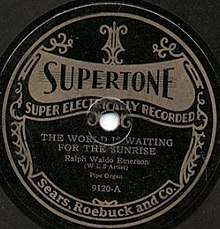The World Is Waiting for the Sunrise
| "The World Is Waiting for the Sunrise" | |
|---|---|
 | |
| Song | |
| Published | 1919 |
| Songwriter(s) |
Composer: Ernest Seitz Lyricist: Gene Lockhart |
"The World Is Waiting for the Sunrise" is a popular ballad with lyrics by Gene Lockhart and music (Toronto 1918) by the concert pianist Ernest Seitz, who had conceived the refrain when he was 12. Embarrassed about writing popular music, Seitz used the pseudonym "Raymond Roberts" when the song was first published by Chappell in 1919.[1]
Legacy
More than 100 recorded versions have been commercially released. Initially, when the song's hopeful sentiment appealed to post-World War One North America, it was recorded by both singers and instrumentalists, including Morton Downey, Fritz Kreisler, Ted Lewis, and John Steel. Later, as a popular vehicle for improvisation, it was recorded by many jazz musicians, among them Benny Goodman, Duke Ellington, Django Reinhardt, Mel Powell, Jess Stacy, Jack Teagarden and Cuban mambo master Machito.
A version made for Capitol in 1951 by guitarists Les Paul and Mary Ford was a million-seller. The Beatles recorded a home version on a Grundig tape recorder in April or May, 1960. The Beatles version featured guitars by Harrison and Lennon and vocals from Paul McCartney. Canadian jazz musicians to record the song include Bert Niosi (1946), Peter Appleyard (1957), Ed Bickert (1979), and Oscar Peterson (1980). A version by doo-wop group the Larks is featured in the 1955 film Rhythm and Blues Revue.
Les Paul's version was one of the first electric guitar recordings to feature distortion. Takeshi Terauchi & Bunnys recorded an instrumental version of the song on their 1967 album, The World Is Waiting For Terry.[2]
One of the most memorable covers of the song was done by Stan Laurel in the Laurel and Hardy film The Flying Deuces (1939), as Laurel takes the bed strings and plays the song on it like a harp. It was an ironic gesture as the boys, who joined the FFL, were caught deserting and were to be shot at dawn.
The song is also referenced in Tennessee Williams's play The Glass Menagerie as the music heard emanating from the Paradise Dance Hall across the alley from the Wingfields' tenement building. The dance hall represents the outside world that Tom hopes in some ways to join.
The Les Paul and Mary Ford version of the song appears in a teaser video released by American band The Voidz to promote their album Virtue. The video was directed by Warren Fu.
References
- ↑ Vogel, Frederick G. (1995). World War I Songs: a History and Dictionary of Popular American Patriotic Tunes with Over 300 Complete Lyrics. Jefferson, North Carolina: McFarland. p. 107. ISBN 0899509525.
- ↑ "The World waiting for TERRY". msato.net.
See also
External links
- Sheet music for "The World is Waiting for the Sunrise", Chappell-Harms, 1919.